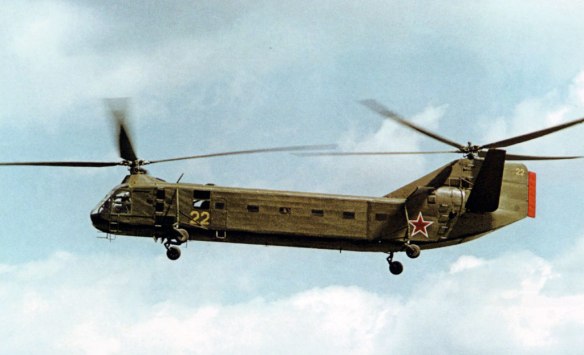
In the late 1940s and early 1950s an experienced Soviet aircraft designer endeavoring to compete with Mil met with scant helicopter success. A. S. Yakovlev had produced several successful fixed-wing aircraft during World War II, and he placed his Yak 100 helicopter into competition with the Mi-1. Yakovlev’s helicopter greatly resembled Sikorsky’s S-51, but it apparently lacked the S-51’s performance. First flown in 1950, the Yak 100 lost a fly-off to the Mi-1, which was adopted by the Soviet military. Yakovlev introduced the Yak 24 in 1953. This helicopter mirrored Piasecki’s tandem rotor design. By 1955 the Yak 24 was the largest flying helicopter in the world, lifting 8,000 pounds to an altitude of 6,000 feet. Known in the USSR as the “Flying Boxcar,” the Yak 24 received the NATO designation “Horse.” The civil version carried thirty passengers, but large Mil helicopters overshadowed the Yak 24.
The initial variant was the Yak-24 – Army transport helicopter, that could carry up to 30 airborne troops, 18 stretchers or 3,000 kg (6,614 lb) of cargo. From 1958, the improved model Yak-24U was produced, with all-metal rotors of bigger diameter (21 m/69 ft) and all-metal fuselage. It could carry 40 soldiers or 3,500 kg (7,716 lb) of cargo, including 2 GAZ-69 jeeps or anti-tank guns. A civilian variant for 30 passengers was the Yak-24A, produced from 1960 in small numbers. It was also used as a flying crane, lifting an external load of 5,000 kg (11,023 lb). There were two proposed models: the Yak-24K 9-seat VIP salon with shorter fuselage and civilian Yak-24P for 39 passengers with stronger 2,013 kW (2,700 hp) turboshaft engines, but neither reached production.
The exact number of Yak-24 helicopters produced was 40 to 100 units, depending on the source of the data, but all sources agree that production was curtailed due to technical problems, and the need for a heavy transport helicopter was fulfilled by the successful Mil Mi-6. According to some sources, the passenger Yak-24A was not actually produced.
#
Specifications (Yak-24U)
General characteristics
Crew: Four (two pilots, flight engineer and radio operator)
Capacity: 40 soldiers, 18 stretchers, or 3,500 kg (7,716 lb) of cargo[2]
Length: 21.34 m[3] (70 ft 0 in)
Rotor diameter: 21.0 m (68 ft 3 in)
Height: 6.50 m (24 ft 4 in)
Disc area: 693 m² (7,454 ft²)
Empty weight: 11,000 kg (24,251 b)
Max takeoff weight: 15,830 kg (34,898 lb)
Powerplant: 2 × Shvetsov ASh-82V 14-cylinder two-row air-cooled radial engines, 1,268 kW (1,700 hp each) each
Performance
Maximum speed: 175 km/h (94 knots, 109 mph)
Range: 265 km (143 nmi, 165 mi)
Service ceiling: 2,700 m (8,900 ft)